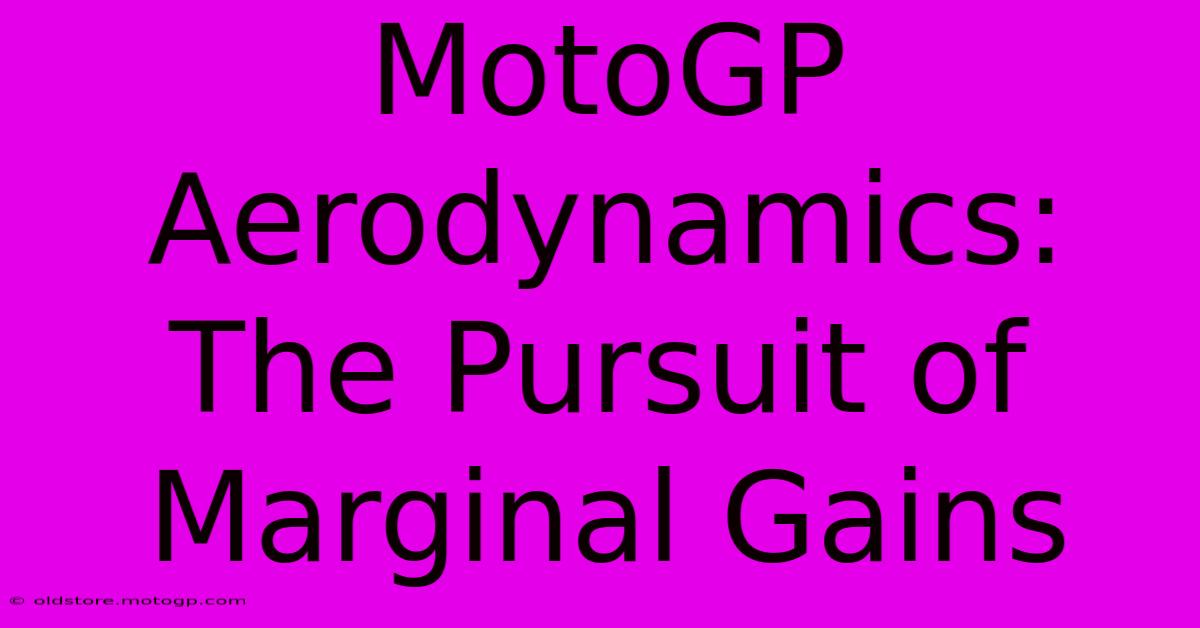MotoGP Aerodynamics: The Pursuit Of Marginal Gains

Table of Contents
MotoGP Aerodynamics: The Pursuit of Marginal Gains
MotoGP racing is a relentless pursuit of speed, a battle for milliseconds where every advantage counts. While rider skill and engine power are crucial, the often-overlooked element that significantly impacts performance is aerodynamics. This article delves into the complex world of MotoGP aerodynamics, exploring how marginal gains in airflow management translate into substantial improvements on the track.
Understanding the Aerodynamic Challenge
MotoGP bikes operate at incredibly high speeds, generating substantial aerodynamic forces. These forces – primarily drag and downforce – directly influence a bike's performance. Drag, the resistance to forward motion, needs to be minimized to achieve higher top speeds. Downforce, on the other hand, pushes the bike towards the track, improving stability and grip at high speeds and during cornering. The challenge lies in finding the optimal balance between these two opposing forces.
Drag Reduction Techniques
Minimizing drag is a crucial aspect of MotoGP aerodynamics. Teams employ various techniques, including:
-
Streamlined Fairings: The design of the fairing (the bodywork surrounding the engine and rider) is paramount. Engineers meticulously sculpt the fairing's shape to reduce air resistance, often using computational fluid dynamics (CFD) simulations to optimize airflow. Even small changes in the fairing's profile can result in noticeable speed gains.
-
Winglet Optimization: Winglets, small aerodynamic appendages, are strategically placed on the fairing to manage airflow and reduce drag. The design and positioning of these winglets are constantly refined, seeking the optimal balance between drag reduction and downforce generation.
-
Surface Texture and Materials: The surface texture of the fairing also plays a role in minimizing drag. Smooth surfaces with minimal imperfections reduce turbulence and improve airflow, enhancing speed. The choice of materials also influences drag, with lightweight, aerodynamically efficient composites being preferred.
Downforce Enhancement: Cornering Mastery
Generating sufficient downforce is vital for high-speed cornering. Excessive downforce can hinder top speed, but insufficient downforce leads to instability and reduced cornering speeds. The pursuit of optimal downforce involves:
-
Aerodynamic Wings: The most prominent aerodynamic devices are the wings, prominently featured on MotoGP bikes. These wings generate significant downforce, allowing riders to maintain higher cornering speeds and brake later into turns. The angle of attack and design of these wings are critical.
-
Underbody Aerodynamics: The airflow under the bike is equally important. The underbody is designed to create a low-pressure zone, generating downforce and improving stability. This area is often overlooked, but it holds significant potential for performance improvement.
-
Bodywork Integration: The seamless integration of various aerodynamic components is crucial. Disruptions in airflow can significantly reduce the effectiveness of downforce-generating elements and increase drag.
The Constant Evolution: Innovation and Regulation
MotoGP aerodynamics is a constantly evolving field. Teams continually refine their designs, pushing the boundaries of what's aerodynamically possible. Regulations often play a significant role, dictating the permitted sizes and configurations of aerodynamic devices. This continuous evolution ensures that the pursuit of marginal gains remains a central theme in MotoGP.
Conclusion: The Quest for Perfection
The pursuit of marginal gains in MotoGP aerodynamics is a never-ending quest for perfection. Even minor improvements in airflow management can translate to significant differences in lap times, ultimately determining the outcome of races. The intricate interplay of drag reduction and downforce enhancement showcases the importance of aerodynamics in this high-stakes motorsport. The constant innovation and development in this field highlight the ongoing dedication to finding that elusive edge, a testament to the sport's relentless drive for speed and precision.

Thank you for visiting our website wich cover about MotoGP Aerodynamics: The Pursuit Of Marginal Gains. We hope the information provided has been useful to you. Feel free to contact us if you have any questions or need further assistance. See you next time and dont miss to bookmark.
Featured Posts
-
Unleash Your Potential Racing Motor Bikes
Feb 21, 2025
-
Moto Gp Sprint Races Get Ready For A Weekend Of Thrills
Feb 21, 2025
-
Racing Style Inspiration Circuit Of The Americas Store Lookbook
Feb 21, 2025
-
Austin F1 Qualifying Expect The Unexpected
Feb 21, 2025
-
Sprint Race Results Redefining Speed
Feb 21, 2025
